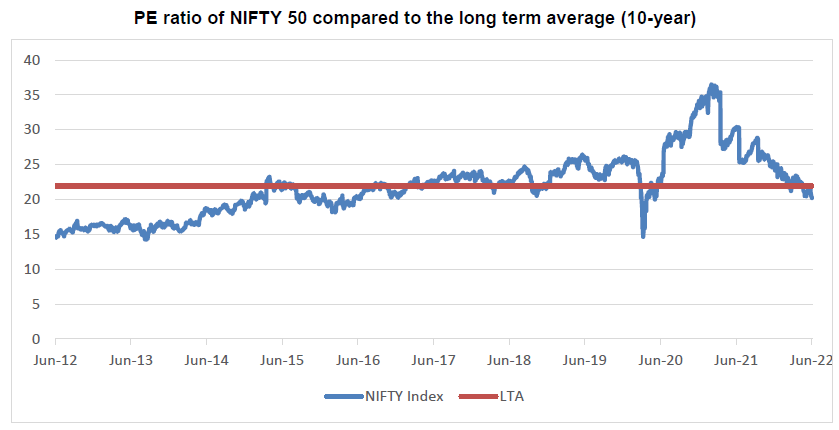How are Indian Equity Valuations currently
Mutual Fund
Background
The decision to buy or sell a stock depends on various indicators (qualitative as well as quantitative) related to the macroeconomic conditions as well as company specific fundamentals which involve analyzing the Profit & Loss statement (P&L) and Balance Sheet. Quantitative analysis of a particular company helps in identifying the intrinsic value (fair value) of the company against the price which it is trading at. Valuation measures provide a guide about the value of a company which can help in making an informed investing decision.
Broadly speaking there are two types of valuation metrics; relative and absolute. Relative valuation ratios allow investors to compare a particular stock to their sector / broader market. Relative ratios can help in gauging the attractiveness of a stock w.r.t the sector / industry that it operates in. While there is a broad gamut of valuation ratios, the most commonly used ones are P/E (Price to Earnings) and P/B (Price to Book).
PE ratio:
Price to earnings ratio is arrived at by dividing the share price of a company by the company’s earnings per share. A PE ratio gives an investor an insight about how much an investor is willing to pay per share for every 1 rupee of earnings. A P/E ratio is a guide (absolute reading) and not a solution to determining whether the stock is overvalued or undervalued. This is because the relative valuation of the sector that the company operates in also needs to be considered before arriving at that decision. Also the ratio needs to be read in tandem with other valuation ratios in order to arrive at a more concrete analysis of a stock / market index.
Using this basic ratio can go a long way in assessing the long term trend of the market. However, these multiples provide a snapshot of the status of the company, not the potential.
The Current market scenario:
Since the beginning of the year, Indian equity markets have corrected on account of an elongated geopolitical conflict between Russia and Ukraine and the consequent rise in key commodity prices. That apart, central banks’ action to tame galloping inflation by raising key rates also punctured the equity market rally.
Indian benchmark indices have corrected 14-15% from all-time highs and consequently, Indian valuation which can be indicated by broader market index Nifty 50, the trailing PE is at 20.2x now. It is currently trading at about 21.5 times FY23 earnings. Indian valuation has always been on a premium over emerging markets, which usually ranges from 15 percent to 90 percent. India's valuation (MSCI India) premium for the MSCI EM Index is over 40% which is in the below average level. Although there are macro-economic issues, India's long-term outlook is good due to its demography and strong growth attributes. But this year relatively high valuations limit the potential for upsides and increase the risk of an annual economic slowdown, especially given the rising interest rate environment with the increasing risk of an economic slowdown in the US that may adversely impact global equities as an asset class.
Another risk that India is facing along with other global economies is the geopolitical and oil related uncertainty as it can depress economic growth due to India’s high dependency on imports of crude and metals. The current PE is reasonably lower than its long term average(LTA) value of 21.9x. Although the current PE is expensive than other emerging markets, it is at a discount to LTA which gives investors an opportunity for long term investment.

Source: Bloomberg. Data as on 15th June 2022
What’s the short term view given by these metrics?
History can be a good guide for us to understand how the market behaves during different PE ranges. We have conducted an exercise by analyzing the past 15 year valuations of Nifty 50 to help us understand this. The outcome is promising and it is clear that when valuations are in a defined bucket there is a direct correlation with the returns that an investor makes over the next 2-3 years.

* <15; 15 to 18; 18 to 21; 21 to 24 and >24 are the 5 PE buckets considered. Source: Bloomberg, Data as on 15th June 2022
The chart on the left tells us the time period for which a particular PE band has existed over the last 15 years. For instance, a PE band >24 has existed 18% of the time. If we combine it with the chart on the right, it gives us an indication of what the average 3 year rolling returns in this PE band has been. So taking the above example, we can see that whenever markets (Nifty 50) has been in a PE band >24, the average 3 year rolling return for the past 15 years has been 10%.
Conclusion
India's current valuations (post the recent correction) presents a decent entry point to taking exposure to Indian equities from a long term point of view. There is a myth that entering at higher valuation multiples leads to poor stock market performance. But as seen above, even at the highest valuation point investors can expect decent returns provided they stay invested for a minimum of 3 years.
Disclaimer
Source of Data: Axis MF Research, Bloomberg.
This document represents the views of Axis Asset Management Co. Ltd. and must not be taken as the basis for an investment decision. Neither Axis Mutual Fund, Axis Mutual Fund Trustee Limited nor Axis Asset Management Company Limited, its Directors or associates shall be liable for any damages including lost revenue or lost profits that may arise from the use of the information contained herein. No representation or warranty is made as to the accuracy, completeness or fairness of the information and opinions contained herein. The material is prepared for general communication and should not be treated as research report. The data used in this material is obtained by Axis AMC from the sources which it considers reliable.
While utmost care has been exercised while preparing this document, Axis AMC does not warrant the completeness or accuracy of the information and disclaims all liabilities, losses and damages arising out of the use of this information. Investors are requested to consult their financial, tax and other advisors before taking any investment decision(s). The AMC reserves the right to make modifications and alterations to this statement as may be required from time to time.
Axis Mutual Fund has been established as a Trust under the Indian Trusts Act, 1882, sponsored by Axis Bank Ltd. (liability restricted to Rs. 1 Lakh). Trustee: Axis Mutual Fund Trustee Ltd. Investment Manager: Axis Asset Management Co. Ltd. (the AMC) Risk Factors: Axis Bank Limited is not liable or responsible for any loss or shortfall resulting from the operation of the scheme.
(Mutual Fund investments are subject to market risks, read all scheme related documents carefully.)
MUTUAL FUND TOOLS & CALCULATORS
Recent News
-
Mr. Navneet Munot's 'Person of the Year 2025'
Dec 31, 2025
-
The Wealth Company Mutual Fund Receives SEBI Approval to Launch Specialized Investment Fund SIF
Nov 26, 2025
-
Axis Mutual Fund Launches Axis Multi Asset Active FoF Fund of Fund: A One Stop Solution for Dynamic Asset Allocation
Nov 21, 2025
-
The Wealth Company Mutual Fund makes record debut with four active NFOs, garners close to Rs 2000CR
Oct 29, 2025
-
Axis MF Launches Axis Income Plus Arbitrage Passive FOF
Oct 28, 2025







